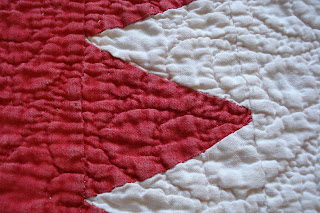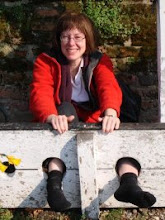is asking us to post about our red and white quilts so that we can have a virtual exhibition - here's a north country red and white quilt from my collection........

This is a red and white strippy which is enhanced by hand sewn triangles forming a zigzag effect. Very striking on the bed! The date is probably 1880-1900; there is some machine stitching on the edges but the patchwork and the quilting is all done by hand. This quilt is also unusual in that the quilting design is an overall one and does not follow the strips.

Here you can see the turkey red fabric - red and white strips alternate with pieced triangles - sometimes known as the Tree of Life pattern.
Turkey Red was a process that created a bright red fabric that was very long lasting and didn't fade -hence very sought after and popular. This is a good example of Turkey Red being used in a quilt.

A photo to show the hand piecing and also the very fine quilting. The quilt was bought at an auction in Rothbury, Northumberland, and had come from a large house clearance. It had been in the same house and family since it was made. The area has a strong tradition of quilt stampers (markers) and this looks as if it was marked by an experienced hand. I traced this design onto polythene - the design is not very visible from the front and is more easily seen on the back. Probably marked and quilted from the back or whole cloth side. It is likely that the white side was considered the "good" side, as patchwork was considered the everyday side.
Patterns seen are feathers, ferns, roses and diamond infill.

The back of the quilt showing the very fine quilting.

On the corners are laundry marks - these identified the owner of the quilt - most households did not do their own washing but sent it out to a laundry, and many older quilts have laundry marks in India ink. Some have paper slips stapled to the quilt instead.

The back of the quilt showing the very fine quilting.

On the corners are laundry marks - these identified the owner of the quilt - most households did not do their own washing but sent it out to a laundry, and many older quilts have laundry marks in India ink. Some have paper slips stapled to the quilt instead.
Although the edges are worn, one can see that one edge is seamed - thus this quilt has "the edge": ie the back and front of the quilt were seamed together at one end before putting into the frame - rediscovered by Pauline Adams. I have discovered this edge technique in several of my quilts, including one from Hawick (Scottish borders) and several Welsh ones, so it was a widespread technique.

Pippa, you saved my day with your last postings of such beautiful, marvellous quilts! I love to look at the pictures again and again and it seems like I can feel the soft fabrics and the quilting structures.
ReplyDeleteAll the quilts here on your blog show exactly what I like most and love to do by myself: wholecloths and strippies, tradtional Welsh and North Country/Durham quilting patterns, fine hand quilting and beautiful fabrics. I hope one day I can come over to UK and see such treasures in reality.
Thank you so much for sharing and for all your work you put in this blog.
What an outstanding quilting design.
ReplyDeleteAnother lovely quilt. . .
ReplyDeleteI was so surprised to see all the quilting from the back. It just doesn't show up on the red and white side. And I thought your comment was interesting about the patchwork being the everyday side. Now, it seems, we do our patchwork to show off our skills and the quilting just holds it all together.
Pippa, I love this quilt!! Thanks so much for adding it and for the interesting information about it. Looking at your blog the last couple of days has me coveting Welsh quilts. My granfather was a Gwynn so perhaps it's in the blood.
ReplyDeleteYes, my paternal grandmother was a Griffith, so Welsh blood there, too. The US relatives have tackled the Palmer, Fuller and Dalke parts of the family tree, but not the Welsh side; not a surprise as Welsh geneology is notoriously difficult. Robin, the wholecloth side is definately the good side, as patchwork came to be associated with poverty - definately seen as recycling and making do - so seen as the everyday side, the good wholecloth side only ocassionally turned over! Pippa
ReplyDeleteIncredible! I've always loved the Tree of Life pattern, but this just may be better. I am really crazy about this quilt!
ReplyDeleteThat`s a gorgeous quilt Pippa! The standard of quilting is stunning and the overall effect is superb!
ReplyDeletethis quilt is just so beautiful
ReplyDeleteI always love visiting your blog, your such a wealth of information and incredible quilts/quilting too:)
thanks for sharing.
Kathie
Stunning quilt and quilting. Thanks for sharing it
ReplyDeleteThat is one lovely quilt.
ReplyDeleteThe quilting is just beautiful!
ReplyDeleteI love it! It's so striking. The quilting is wonderful. Thanks for sharing.
ReplyDelete